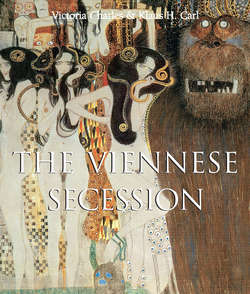Читать книгу The Viennese Secession - Victoria Charles - Страница 3
Vienna in the Second Half of the 19th Century
ОглавлениеEven though the Viennese upper class were passionately fond of dances, the opera, theatre, and music, they remained extremely conservative. Strict Catholicism accompanied by rigid social morals made them seem, at least in appearance, unmoving and close-lipped. While the rest of society was only too happy to embrace all sorts of pleasures then deemed sensual, for example the waltz, the so-called “good” society rejected any topic that was unaesthetic, erotic or even mildly sexual. Thus different standards were applied to different strata of society, which is telling about the dominant concept of morality in Vienna in particular, and the Austro-Hungarian Empire in general, at the end of the 19th century.
In these decades, Vienna was a city at the zenith of its power and influence. Kaiser Franz Joseph I was the monarch of an empire of over fifty million people, encompassing several dozen constituent kingdoms and duchies from Bohemia to Serbia. However, at the end of World War I, at the beginning of 1918, the empire only had several months of existence left. With Kaiser Karl’s failed attempt to conserve the empire in the form of a federal state, Austria suddenly became a small nation of seven million inhabitants, of which three million lived in and around Vienna. Barely twenty years later, Nazi Germany under Adolf Hitler (1889–1945) would annex the Republic, thus sealing its fate in the tumultuous years to follow.
However, the decline of Austria had begun long before the events of 1918 or 1934. A succession of military defeats were already a clear warning sign that the prolonged existence of the empire was not guaranteed. Furthermore, the rising impoverishment of thousands of Czechs, Hungarians, Poles, Jews, Romanians, and Romani led many to leave the poorest parts of the empire to look for work in the capital. However, their lot did not improve as the city could not provide enough work and accommodation, which led them to live in worse conditions than before. These social problems were ignored by the rich and influential citizens of Vienna who decided to blind and distract themselves with a true flurry of pleasure-filled activities instead.
These developments also influenced the decorative arts, which witnessed a lot of change and upheaval between the decline of the influential French style and the World Fair in Paris in 1889, which was held in honour of the hundredth birthday of the French Revolution. There was no simple and fluid transition from one style to another. Between the rise of new ideas and artistic techniques, older styles were consistently resurrected. Even as late as 1900, artistic influences popularised during the time of the European Restoration, or French art during the reign of Napoleon III (1808–1873), could still be seen in the exhibits of the World Fair. However, the imitation of these styles was not consistent enough for a coherent movement to form, mainly because there were many artists who wanted to distinguish themselves from their predecessors by expressing their own decorative ideals.
Despite their novelty, these new movements were not isolated from the influences of their predecessors. They were characterised by weariness from seeing the old forms and patterns repeated over and over again, from having to face the infinite imitation of furniture from the time of the French kings that all answered to the name of “Louis”, beginning with Louis XIII (1601–1643), followed by Louis XIV (1643–1715) to Louis XVI (1754–1793). They also were characterised by a general dismissal of the common shapes and pattern of the Gothic style and the Renaissance. In essence, this new movement stood for the acceptance of a new art that was grounded in the modern age and not dependant on previous influences for credibility.
Émile Gallé, Orchid Vase.
Glass with inserted ornaments and relief.
Private collection.
Louis Comfort Tiffany, Fluted Flower-Form Vase, between 1900 and 1905.
Lead glass.
Before 1789, the year that marked the end of the Ancien Régime, different styles usually developed with dependence on the monarchs; this new century wanted its own style. The desire for freedom from art and fashion dictated by rulers and sovereigns was not only perceivable in France but also beyond its borders. Many countries in Europe witnessed the slow awakening of proud nationalism that was rooted in the wish for literature and art that could be called their own. In short, this desire created an emergence of new understanding and appreciation of art that was not a servile copy of past glory and even less an imitation of foreign influences. In addition, contrary to previous decades, the need for applied art skyrocketed, mainly because this branch of art had nearly died out in the 19th century. In the past, everything was richly decorated: from home décor and dresses to weapons and simple household objects. Every object possessed its own ornaments and its own beauty and elegance. The 19th century, on the other hand, essentially looked for functionality rather than elegance. Beauty, elegance and ornaments became superfluous. This century, which began with a totalitarian indifference towards decorative beauty and elegance and ended so sadly in the drutal disregardof international human rights, was characterised by a paralysis of taste and aesthetics.
The return of the exiled concept of aesthetics was also at the heart of the Art Nouveau movement and its Austro-German manifestation, the Jugendstil. In France, people began to feel the absurdity of the situation and started to demand creativity, innovation and authenticity from cabinetmakers, decorators, stucco specialists, and even architects. This gave rise to a form of applied art that directly catered to the need of a new generation.
